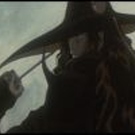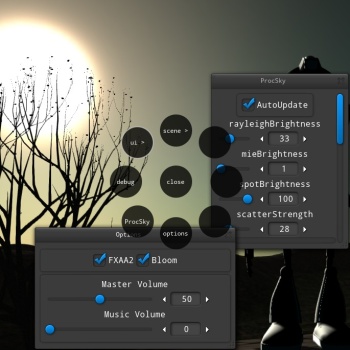Hi. Sorry to double post. You were right, it worked. I decided to load the last version of Urho directly from GITHUB (03/20/16) and try to build it with it. There are new keywords that have been changed since with the URHO3D_ prefix.
For using this with URHO 1.5 (last revision) you will have to replace 4 files from the example folder (54_Turbobadger folder)(this only affect the demo source, the source for TurboBadger I had is unchanged).
First file:
UIDRAG.H
[code]//
// Copyright © 2008-2015 the Urho3D project.
//
// Permission is hereby granted, free of charge, to any person obtaining a copy
// of this software and associated documentation files (the “Software”), to deal
// in the Software without restriction, including without limitation the rights
// to use, copy, modify, merge, publish, distribute, sublicense, and/or sell
// copies of the Software, and to permit persons to whom the Software is
// furnished to do so, subject to the following conditions:
//
// The above copyright notice and this permission notice shall be included in
// all copies or substantial portions of the Software.
//
// THE SOFTWARE IS PROVIDED “AS IS”, WITHOUT WARRANTY OF ANY KIND, EXPRESS OR
// IMPLIED, INCLUDING BUT NOT LIMITED TO THE WARRANTIES OF MERCHANTABILITY,
// FITNESS FOR A PARTICULAR PURPOSE AND NONINFRINGEMENT. IN NO EVENT SHALL THE
// AUTHORS OR COPYRIGHT HOLDERS BE LIABLE FOR ANY CLAIM, DAMAGES OR OTHER
// LIABILITY, WHETHER IN AN ACTION OF CONTRACT, TORT OR OTHERWISE, ARISING FROM,
// OUT OF OR IN CONNECTION WITH THE SOFTWARE OR THE USE OR OTHER DEALINGS IN
// THE SOFTWARE.
//
#pragma
once
#include
<Urho3D/Core/Object.h>
#include
<TurboBadger/tb_widgets_listener.h>
#include
“Sample.h”
namespace Urho3D
{
class Node;
class Scene;
}
namespace tb
{
class TBMessageWindow;
}
using namespace Urho3D;
using namespace tb;
//=====================================
URHO3D_EVENT(E_TBMSG, TBMessageNamespace)
{
URHO3D_PARAM(P_TBWIDGET, Widget); // TBWidget pointer
}
//=============================================================================
//=============================================================================
class UTBListener : public Object, public TBWidgetListener
{
URHO3D_OBJECT(UTBListener, Object);
public:
UTBListener(Context *context);
~UTBListener();
void CreateMsgWindow();
virtual void OnWidgetRemove(TBWidget *parent, TBWidget *child);
virtual bool OnWidgetInvokeEvent(TBWidget *widget, const TBWidgetEvent &ev);
TBWidget* GetTBMessageWidget()
{
return (TBWidget*)pTBMessageWindow_;
}
protected:
void SendEventMsg();
protected:
TBMessageWindow *pTBMessageWindow_;
};
//=============================================================================
//=============================================================================
/// GUI test example.
/// This sample demonstrates:
/// - Creating GUI elements from C++
/// - Loading GUI Style from xml
/// - Subscribing to GUI drag events and handling them.
class UIDrag : public Sample
{
URHO3D_OBJECT(UIDrag,Sample);
public:
/// Construct.
UIDrag(Context* context);
~UIDrag();
/// Setup after engine initialization and before running the main loop.
virtual void Setup();
virtual void Start();
virtual void Stop();
protected:
void HandleTBMessage(StringHash eventType, VariantMap& eventData);
/// Return XML patch instructions for screen joystick layout for a specific sample app, if any.
virtual String GetScreenJoystickPatchString() const { return
"<patch>"
" <add sel=\"/element/element[./attribute[@name='Name' and @value='Hat0']]\">"
" <attribute name=\"Is Visible\" value=\"false\" />"
" </add>"
"</patch>";
}
UTBListener *pTBListener_;
};
[/code]
UIDRAG.CPP
[code]//
// Copyright © 2008-2015 the Urho3D project.
//
// Permission is hereby granted, free of charge, to any person obtaining a copy
// of this software and associated documentation files (the “Software”), to deal
// in the Software without restriction, including without limitation the rights
// to use, copy, modify, merge, publish, distribute, sublicense, and/or sell
// copies of the Software, and to permit persons to whom the Software is
// furnished to do so, subject to the following conditions:
//
// The above copyright notice and this permission notice shall be included in
// all copies or substantial portions of the Software.
//
// THE SOFTWARE IS PROVIDED “AS IS”, WITHOUT WARRANTY OF ANY KIND, EXPRESS OR
// IMPLIED, INCLUDING BUT NOT LIMITED TO THE WARRANTIES OF MERCHANTABILITY,
// FITNESS FOR A PARTICULAR PURPOSE AND NONINFRINGEMENT. IN NO EVENT SHALL THE
// AUTHORS OR COPYRIGHT HOLDERS BE LIABLE FOR ANY CLAIM, DAMAGES OR OTHER
// LIABILITY, WHETHER IN AN ACTION OF CONTRACT, TORT OR OTHERWISE, ARISING FROM,
// OUT OF OR IN CONNECTION WITH THE SOFTWARE OR THE USE OR OTHER DEALINGS IN
// THE SOFTWARE.
//
#include
<Urho3D/Urho3D.h>
#include
“UIDrag.h”
#include
“UTBRendererBatcher.h”
#include
“TBDemo.h”
#include
<Urho3D/DebugNew.h>
//=============================================================================
//=============================================================================
URHO3D_DEFINE_APPLICATION_MAIN(UIDrag)
//=============================================================================
//=============================================================================
UIDrag::UIDrag(Context* context) :
Sample(context), pTBListener_( NULL )
{
}
UIDrag::~UIDrag()
{
if ( pTBListener_ )
{
delete pTBListener_;
pTBListener_ = NULL;
}
}
//=============================================================================
//=============================================================================
void UIDrag::Setup()
{
// Modify engine startup parameters
engineParameters_[“WindowTitle”] = GetTypeName();
engineParameters_[“LogName”] = GetSubsystem()->GetAppPreferencesDir(“urho3d”, “logs”) + GetTypeName() + “.log”;
engineParameters_[“FullScreen”] = false;
engineParameters_[“Headless”] = false;
engineParameters_[“WindowWidth”] = 1280;
engineParameters_[“WindowHeight”] = 720;
}
//=============================================================================
//=============================================================================
void UIDrag::Start()
{
// Execute base class startup
Sample::Start();
// Set mouse visible
String platform = GetPlatform();
if (platform != "Android" && platform != "iOS")
GetSubsystem<Input>()->SetMouseVisible(true);
// create TB render batcher
Graphics *graphics = GetSubsystem<Graphics>();
UTBRendererBatcher::Create( GetContext(), graphics->GetWidth(), graphics->GetHeight() );
UTBRendererBatcher::Singleton().Init( "Data/TB/" );
// create a msg win
pTBListener_ = new UTBListener( GetContext() );
pTBListener_->CreateMsgWindow();
SubscribeToEvent(E_TBMSG, URHO3D_HANDLER(UIDrag, HandleTBMessage));
}
void UIDrag::Stop()
{
TBDemo::Destroy();
UTBRendererBatcher::Destroy();
Sample::Stop();
}
void UIDrag::HandleTBMessage(StringHash eventType, VariantMap& eventData)
{
using namespace TBMessageNamespace;
TBWidget *pTBWidget = (TBWidget*)eventData[P_TBWIDGET].GetVoidPtr();
if ( pTBListener_->GetTBMessageWidget() == pTBWidget )
{
TBDemo::Init();
}
}
//=============================================================================
//=============================================================================
UTBListener::UTBListener(Context *context)
: Object(context)
, pTBMessageWindow_( NULL )
{
}
UTBListener::~UTBListener()
{
if ( pTBMessageWindow_ )
{
pTBMessageWindow_ = NULL;
}
}
void UTBListener::CreateMsgWindow()
{
TBStr text("\nHellow World from Turbo Badger.\n\nClick OK to get started.");
pTBMessageWindow_ = new TBMessageWindow( &UTBRendererBatcher::Singleton().Root(), TBIDC("") );
pTBMessageWindow_->Show(“Start Message”, text);
TBWidgetListener::AddGlobalListener( this );
}
void UTBListener::OnWidgetRemove(TBWidget *parent, TBWidget *child)
{
if ( pTBMessageWindow_ == child )
{
TBWidgetListener::RemoveGlobalListener( this );
}
}
bool UTBListener::OnWidgetInvokeEvent(TBWidget *widget, const TBWidgetEvent &ev)
{
if ( pTBMessageWindow_ && pTBMessageWindow_ == ev.target )
{
if ( ev.type == EVENT_TYPE_CLICK )
{
TBWidgetListener::RemoveGlobalListener( this );
SendEventMsg();
}
}
return false;
}
void UTBListener::SendEventMsg()
{
using namespace TBMessageNamespace;
VariantMap& eventData = GetEventDataMap();
eventData[P_TBWIDGET] = GetTBMessageWidget();
SendEvent( E_TBMSG, eventData );
}
[/code]
UTBRendererBatcher.h
[code]//=============================================================================
// Copyright © 2015 LumakSoftware
//
//=============================================================================
#pragma
once
#include
<Urho3D/Urho3D.h>
#include
<TurboBadger/tb_widgets.h>
#include
<TurboBadger/tb_renderer.h>
#include
<TurboBadger/renderers/tb_renderer_batcher.h>
namespace Urho3D
{
class Context;
class VertexBuffer;
class Texture2D;
}
//=============================================================================
//=============================================================================
using namespace Urho3D;
using namespace tb;
//=============================================================================
//=============================================================================
class UTBBitmap : public TBBitmap
{
public:
UTBBitmap(Context *_pContext, int _width, int _height);
~UTBBitmap();
// =========== virtual methods required for TBBitmap subclass =========
virtual void SetData(uint32 *_pdata)
{
texture_->SetData( 0, 0, 0, width_, height_, _pdata );
}
virtual int Width() { return width_; }
virtual int Height(){ return height_; }
SharedPtr<Context> context_;
SharedPtr<Texture2D> texture_;
int width_;
int height_;
};
//=============================================================================
//=============================================================================
class UTBRendererBatcher : public UIElement, public TBRendererBatcher
{
URHO3D_OBJECT( UTBRendererBatcher, UIElement );
public:
// static funcs
static void Create(Context *_pContext, int
iwidth, int
iheight)
{
if ( pSingleton
== NULL )
{
pSingleton
= new UTBRendererBatcher( _pContext, _iwidth, _iheight );
}
}
static void Destroy()
{
if ( pSingleton_ )
{
pSingleton_->Remove();
pSingleton_ = NULL;
}
}
static UTBRendererBatcher& Singleton() { return *pSingleton_; }
// methods
void Init(const String &_strDataPath);
void LoadDefaultResources();
TBWidget& Root() { return root_; }
const String& GetDataPath() { return strDataPath_; }
// override funcs
virtual void BeginPaint(int render_target_w, int render_target_h);
virtual void EndPaint();
// UIElement override method to add TB batches
virtual void GetBatches(PODVector<UIBatch>& batches, PODVector<float>& vertexData, const IntRect& currentScissor);
// ===== methods that need implementation in TBRendererBatcher subclasses =====
virtual TBBitmap* CreateBitmap(int width, int height, uint32 *data);
virtual void RenderBatch(Batch *batch);
virtual void SetClipRect(const TBRect &rect)
{
m_clip_rect = rect;
}
protected:
// override methods
virtual void AddQuadInternal(const TBRect &dst_rect, const TBRect &src_rect, uint32 color, TBBitmap *bitmap, TBBitmapFragment *fragment);
protected:
UTBRendererBatcher(Context *_pContext, int _iwidth, int _iheight);
virtual ~UTBRendererBatcher();
void OnResizeWin(int _iwidth, int _iheight);
void CreateKeyMap();
void RegisterHandlers();
void HandleUpdate(StringHash eventType, VariantMap& eventData);
// renderer
void HandleScreenMode(StringHash eventType, VariantMap& eventData);
void HandleBeginFrame(StringHash eventType, VariantMap& eventData);
void HandlePostUpdate(StringHash eventType, VariantMap& eventData);
void HandlePostRenderUpdate(StringHash eventType, VariantMap& eventData);
// inputs
void HandleMouseButtonDown(StringHash eventType, VariantMap& eventData);
void HandleMouseButtonUp(StringHash eventType, VariantMap& eventData);
void HandleMouseMove(StringHash eventType, VariantMap& eventData);
void HandleMouseWheel(StringHash eventType, VariantMap& eventData);
void HandleKeyDown(StringHash eventType, VariantMap& eventData);
void HandleKeyUp(StringHash eventType, VariantMap& eventData);
void HandleTextInput(StringHash eventType, VariantMap& eventData);
// TB special and quality keys func
int FindTBKey(int _ikey);
protected:
static UTBRendererBatcher *pSingleton_;
TBWidget root_;
PODVector<float> vertexData_;
PODVector<UIBatch> batches_;
String strDataPath_;
HashMap<int, int> uKeytoTBkeyMap;
IntVector2 lastMousePos_;
};
[/code]
UTBRendererBatcher.cpp
[code]//=============================================================================
// Copyright © 2015 LumakSoftware
//
//=============================================================================
#include
<Urho3D/Urho3D.h>
#include
<Urho3D/Core/Context.h>
#include
<Urho3D/Core/Object.h>
#include
<Urho3D/Core/CoreEvents.h>
#include
<Urho3D/UI/UI.h>
#include
<Urho3D/UI/UIElement.h>
#include
<Urho3D/UI/UIEvents.h>
#include
<Urho3D/Graphics/Graphics.h>
#include
<Urho3D/Graphics/GraphicsEvents.h>
#include
<Urho3D/Graphics/VertexBuffer.h>
#include
<Urho3D/Graphics/Texture2D.h>
#include
<Urho3D/Resource/ResourceCache.h>
#include
<Urho3D/IO/FileSystem.h>
#include
<Urho3D/Input/InputEvents.h>
#include
<TurboBadger/tb_font_renderer.h>
#include
<TurboBadger/tb_widgets.h>
#include
<TurboBadger/tb_bitmap_fragment.h>
#include
<TurboBadger/tb_system.h>
#include
<TurboBadger/tb_msg.h>
#include
<TurboBadger/tb_language.h>
#include
<TurboBadger/animation/tb_animation.h>
#include
<TurboBadger/animation/tb_widget_animation.h>
#include
“UTBRendererBatcher.h”
#include
<Urho3D/DebugNew.h>
//=============================================================================
//=============================================================================
#define
QAL_VAL 0x60000000 // value to offset qualifier keys from all other keys in the same hash map
//=============================================================================
//=============================================================================
UTBRendererBatcher* UTBRendererBatcher::pSingleton_ = NULL;
//=============================================================================
//=============================================================================
UTBBitmap::UTBBitmap(Context *
pContext, int
width, int
height)
: context
(
pContext )
, width
(
width )
, height
(
height )
, texture
( NULL )
{
texture
= new Texture2D( context
);
// set texture format
texture_->SetMipsToSkip( QUALITY_LOW, 0 );
texture_->SetNumLevels( 1 );
texture_->SetSize( width_, height_, Graphics::GetRGBAFormat() );
// set uv modes
texture_->SetAddressMode( COORD_U, ADDRESS_WRAP );
texture_->SetAddressMode( COORD_V, ADDRESS_WRAP );
}
//=============================================================================
//=============================================================================
UTBBitmap::~UTBBitmap()
{
if ( texture_ )
{
texture_ = NULL;
}
}
//=============================================================================
//=============================================================================
UTBRendererBatcher::UTBRendererBatcher(Context *_pContext, int _iwidth, int _iheight)
: UIElement( _pContext )
, TBRendererBatcher()
{
SetPosition( 0, 0 );
OnResizeWin( _iwidth, _iheight );
}
//=============================================================================
//=============================================================================
UTBRendererBatcher::~UTBRendererBatcher()
{
vertexData_.Clear();
batches_.Clear();
uKeytoTBkeyMap.Clear();
TBWidgetsAnimationManager::Shutdown();
// shutdown
tb_core_shutdown();
}
//=============================================================================
//=============================================================================
void UTBRendererBatcher::OnResizeWin(int _iwidth, int _iheight)
{
m_screen_rect = TBRect( 0, 0, _iwidth, _iheight );
SetSize( _iwidth, _iheight );
root_.SetRect( m_screen_rect );
}
//=============================================================================
//=============================================================================
void UTBRendererBatcher::Init(const String &_strDataPath)
{
// register with UI
GetSubsystem()->GetRoot()->AddChild( this );
// store data path
strDataPath_ = GetSubsystem<FileSystem>()->GetProgramDir() + _strDataPath;
// init tb core
tb_core_init( this );
// load resources
LoadDefaultResources();
// map keys
CreateKeyMap();
// register handlers
RegisterHandlers();
}
//=============================================================================
//=============================================================================
void UTBRendererBatcher::LoadDefaultResources()
{
g_tb_lng->Load(“resources/language/lng_en.tb.txt”);
// Load the default skin, and override skin that contains the graphics specific to the demo.
g_tb_skin->Load("resources/default_skin/skin.tb.txt", "demo01/skin/skin.tb.txt");
// **README**
// - define TB_FONT_RENDERER_FREETYPE in tb_config.h for non-demo
#ifdef
TB_FONT_RENDERER_TBBF
void register_tbbf_font_renderer();
register_tbbf_font_renderer();
#endif
#ifdef
TB_FONT_RENDERER_STB
void register_stb_font_renderer();
register_stb_font_renderer();
#endif
#ifdef
TB_FONT_RENDERER_FREETYPE
void register_freetype_font_renderer();
register_freetype_font_renderer();
#endif
// Add fonts we can use to the font manager.
#if
defined(TB_FONT_RENDERER_STB) || defined(TB_FONT_RENDERER_FREETYPE)
g_font_manager->AddFontInfo(“resources/vera.ttf”, “Vera”);
#endif
#ifdef
TB_FONT_RENDERER_TBBF
g_font_manager->AddFontInfo(“resources/default_font/segoe_white_with_shadow.tb.txt”, “Segoe”);
g_font_manager->AddFontInfo(“fonts/neon.tb.txt”, “Neon”);
g_font_manager->AddFontInfo(“fonts/orangutang.tb.txt”, “Orangutang”);
g_font_manager->AddFontInfo(“fonts/orange.tb.txt”, “Orange”);
#endif
// Set the default font description for widgets to one of the fonts we just added
TBFontDescription fd;
#ifdef
TB_FONT_RENDERER_TBBF
fd.SetID(TBIDC(“Segoe”));
#else
fd.SetID(TBIDC(“Vera”));
#endif
fd.SetSize(g_tb_skin->GetDimensionConverter()->DpToPx(14));
g_font_manager->SetDefaultFontDescription(fd);
// Create the font now.
TBFontFace *font = g_font_manager->CreateFontFace(g_font_manager->GetDefaultFontDescription());
// Render some glyphs in one go now since we know we are going to use them. It would work fine
// without this since glyphs are rendered when needed, but with some extra updating of the glyph bitmap.
if ( font )
{
font->RenderGlyphs(" !\"#$%&'()*+,-./0123456789:;<=>?@ABCDEFGHIJKLMNOPQRSTUVWXYZ[\\]^_`abcdefghijklmnopqrstuvwxyz{|}~????????");
}
root_.SetSkinBg(TBIDC("background"));
TBWidgetsAnimationManager::Init();
}
//=============================================================================
//=============================================================================
void UTBRendererBatcher::CreateKeyMap()
{
// special keys
uKeytoTBkeyMap.Insert( Pair<int,int>( KEY_UP , TB_KEY_UP ) );
uKeytoTBkeyMap.Insert( Pair<int,int>( KEY_DOWN , TB_KEY_DOWN ) );
uKeytoTBkeyMap.Insert( Pair<int,int>( KEY_LEFT , TB_KEY_LEFT ) );
uKeytoTBkeyMap.Insert( Pair<int,int>( KEY_RIGHT , TB_KEY_RIGHT ) );
uKeytoTBkeyMap.Insert( Pair<int,int>( KEY_PAGEUP , TB_KEY_PAGE_UP ) );
uKeytoTBkeyMap.Insert( Pair<int,int>( KEY_PAGEDOWN , TB_KEY_PAGE_DOWN ) );
uKeytoTBkeyMap.Insert( Pair<int,int>( KEY_HOME , TB_KEY_HOME ) );
uKeytoTBkeyMap.Insert( Pair<int,int>( KEY_END , TB_KEY_END ) );
uKeytoTBkeyMap.Insert( Pair<int,int>( KEY_TAB , TB_KEY_TAB ) );
uKeytoTBkeyMap.Insert( Pair<int,int>( KEY_BACKSPACE, TB_KEY_BACKSPACE ) );
uKeytoTBkeyMap.Insert( Pair<int,int>( KEY_INSERT , TB_KEY_INSERT ) );
uKeytoTBkeyMap.Insert( Pair<int,int>( KEY_DELETE , TB_KEY_DELETE ) );
uKeytoTBkeyMap.Insert( Pair<int,int>( KEY_RETURN , TB_KEY_ENTER ) );
uKeytoTBkeyMap.Insert( Pair<int,int>( KEY_ESC , TB_KEY_ESC ) );
uKeytoTBkeyMap.Insert( Pair<int,int>( KEY_F1 , TB_KEY_F1 ) );
uKeytoTBkeyMap.Insert( Pair<int,int>( KEY_F2 , TB_KEY_F2 ) );
uKeytoTBkeyMap.Insert( Pair<int,int>( KEY_F3 , TB_KEY_F3 ) );
uKeytoTBkeyMap.Insert( Pair<int,int>( KEY_F4 , TB_KEY_F4 ) );
uKeytoTBkeyMap.Insert( Pair<int,int>( KEY_F5 , TB_KEY_F5 ) );
uKeytoTBkeyMap.Insert( Pair<int,int>( KEY_F6 , TB_KEY_F6 ) );
uKeytoTBkeyMap.Insert( Pair<int,int>( KEY_F7 , TB_KEY_F7 ) );
uKeytoTBkeyMap.Insert( Pair<int,int>( KEY_F8 , TB_KEY_F8 ) );
uKeytoTBkeyMap.Insert( Pair<int,int>( KEY_F9 , TB_KEY_F9 ) );
uKeytoTBkeyMap.Insert( Pair<int,int>( KEY_F10 , TB_KEY_F10 ) );
uKeytoTBkeyMap.Insert( Pair<int,int>( KEY_F11 , TB_KEY_F11 ) );
uKeytoTBkeyMap.Insert( Pair<int,int>( KEY_F12 , TB_KEY_F12 ) );
// qualifiers: add QAL_VAL to qual keys to separate their range from rest of the keys
uKeytoTBkeyMap.Insert( Pair<int,int>( QUAL_SHIFT + QAL_VAL, TB_SHIFT ) );
uKeytoTBkeyMap.Insert( Pair<int,int>( QUAL_CTRL + QAL_VAL, TB_CTRL ) );
uKeytoTBkeyMap.Insert( Pair<int,int>( QUAL_ALT + QAL_VAL, TB_ALT ) );
uKeytoTBkeyMap.Insert( Pair<int,int>( QUAL_ANY + QAL_VAL, TB_SUPER ) );
}
//=============================================================================
//=============================================================================
TBBitmap* UTBRendererBatcher::CreateBitmap(int width, int height, uint32 *data)
{
UTBBitmap *pUTBBitmap = new UTBBitmap( GetContext(), width, height );
FlushBitmap( (TBBitmap*)pUTBBitmap );
pUTBBitmap->SetData( data );
return (TBBitmap*)pUTBBitmap;
}
//=============================================================================
//=============================================================================
void UTBRendererBatcher::RenderBatch(Batch *_pb)
{
if ( _pb )
{
UTBBitmap
pUTBBitmap = (UTBBitmap
)
pb->bitmap;
SharedPtr tdummy;
SharedPtr texture = pUTBBitmap?pUTBBitmap->texture
: tdummy;
IntRect scissor( _pb->clipRect.x, _pb->clipRect.y, _pb->clipRect.x + _pb->clipRect.w, _pb->clipRect.y +
pb->clipRect.h );
UIBatch batch( this, BLEND_ALPHA, scissor, texture, &vertexData
);
unsigned begin = batch.vertexData_->Size();
batch.vertexData_->Resize(begin + _pb->vertex_count * UI_VERTEX_SIZE);
float* dest = &(batch.vertexData_->At(begin));
// set start/end
batch.vertexStart_ = begin;
batch.vertexEnd_ = batch.vertexData_->Size();
for ( int i = 0; i < _pb->vertex_count; ++i )
{
dest[0+i*UI_VERTEX_SIZE] = _pb->vertex[i].x;
dest[1+i*UI_VERTEX_SIZE] = _pb->vertex[i].y;
dest[2+i*UI_VERTEX_SIZE] = 0.0f;
((unsigned&)dest[3+i*UI_VERTEX_SIZE]) = _pb->vertex[i].col;
dest[4+i*UI_VERTEX_SIZE] = _pb->vertex[i].u;
dest[5+i*UI_VERTEX_SIZE] = _pb->vertex[i].v;
}
// store
UIBatch::AddOrMerge( batch, batches_ );
}
}
//=============================================================================
//=============================================================================
void UTBRendererBatcher::GetBatches(PODVector& batches, PODVector& vertexData, const IntRect& currentScissor)
{
for ( unsigned i = 0; i < batches_.Size(); ++i )
{
// get batch
UIBatch &batch = batches_[ i ];
unsigned beg = batch.vertexStart_;
unsigned end = batch.vertexEnd_;
batch.vertexStart_ = vertexData.Size();
batch.vertexEnd_ = vertexData.Size() + (end - beg);
// resize and copy
vertexData.Resize( batch.vertexEnd_ );
memcpy( &vertexData[ batch.vertexStart_ ], &vertexData_[ beg ], (end - beg) * sizeof(float) );
// store
UIBatch::AddOrMerge( batch, batches );
}
// clear buffers
vertexData_.Clear();
batches_.Clear();
}
//=============================================================================
//=============================================================================
void UTBRendererBatcher::BeginPaint(int render_target_w, int render_target_h)
{
TBRendererBatcher::BeginPaint( render_target_w, render_target_h );
}
//=============================================================================
//=============================================================================
void UTBRendererBatcher::EndPaint()
{
TBRendererBatcher::EndPaint();
}
//=============================================================================
// TBRendererBatcher::AddQuadInternal function override
// ** move this to TurboBadger/renderers/tb_renderer_batcher.cpp once you understand the changes, as this function should be in the library
//=============================================================================
void UTBRendererBatcher::AddQuadInternal(const TBRect &dst_rect, const TBRect &src_rect, uint32 color,
TBBitmap *bitmap, TBBitmapFragment *fragment)
{
if (batch.bitmap != bitmap)
{
batch.Flush(this);
batch.bitmap = bitmap;
}
batch.fragment = fragment;
// save clip rect
// **note** the clipRect member var, as declared below, was added to the Batch class in tb_renderer_batcher.h
// TBRect clipRect;
batch.clipRect = m_clip_rect;
if ( bitmap )
{
// ** Urho3D adds UV offset when using DX, see:
// https://github.com/urho3d/Urho3D/commit/0990fd72f239594fae113820233d1f858325f8dd
#ifdef URHO3D_OPENGL
float uvOffset = 0.0f;
#else
float uvOffset = 0.5f;
#endif
int bitmap_w = bitmap->Width();
int bitmap_h = bitmap->Height();
m_u = (float)(src_rect.x + uvOffset)/ bitmap_w;
m_v = (float)(src_rect.y + uvOffset)/ bitmap_h;
m_uu = (float)(src_rect.x + uvOffset + src_rect.w) / bitmap_w;
m_vv = (float)(src_rect.y + uvOffset + src_rect.h) / bitmap_h;
}
// change triangle winding order to clock-wise
Vertex *ver = batch.Reserve(this, 6);
ver[0].x = (float) dst_rect.x;
ver[0].y = (float) (dst_rect.y + dst_rect.h);
ver[0].u = m_u;
ver[0].v = m_vv;
ver[0].col = color;
ver[2].x = (float) (dst_rect.x + dst_rect.w);
ver[2].y = (float) (dst_rect.y + dst_rect.h);
ver[2].u = m_uu;
ver[2].v = m_vv;
ver[2].col = color;
ver[1].x = (float) dst_rect.x;
ver[1].y = (float) dst_rect.y;
ver[1].u = m_u;
ver[1].v = m_v;
ver[1].col = color;
ver[3].x = (float) dst_rect.x;
ver[3].y = (float) dst_rect.y;
ver[3].u = m_u;
ver[3].v = m_v;
ver[3].col = color;
ver[5].x = (float) (dst_rect.x + dst_rect.w);
ver[5].y = (float) (dst_rect.y + dst_rect.h);
ver[5].u = m_uu;
ver[5].v = m_vv;
ver[5].col = color;
ver[4].x = (float) (dst_rect.x + dst_rect.w);
ver[4].y = (float) dst_rect.y;
ver[4].u = m_uu;
ver[4].v = m_v;
ver[4].col = color;
// Update fragments batch id (See FlushBitmapFragment)
if (fragment)
fragment->m_batch_id = batch.batch_id;
}
//=============================================================================
//=============================================================================
void UTBRendererBatcher::RegisterHandlers()
{
// timer
SubscribeToEvent(E_UPDATE, URHO3D_HANDLER(UTBRendererBatcher, HandleUpdate));
// screen resize and renderer
SubscribeToEvent(E_SCREENMODE, URHO3D_HANDLER(UTBRendererBatcher, HandleScreenMode));
SubscribeToEvent(E_BEGINFRAME, URHO3D_HANDLER(UTBRendererBatcher, HandleBeginFrame));
SubscribeToEvent(E_POSTUPDATE, URHO3D_HANDLER(UTBRendererBatcher, HandlePostUpdate));
SubscribeToEvent(E_POSTRENDERUPDATE, URHO3D_HANDLER(UTBRendererBatcher, HandlePostRenderUpdate));
// inputs
SubscribeToEvent(E_MOUSEBUTTONDOWN, URHO3D_HANDLER(UTBRendererBatcher, HandleMouseButtonDown));
SubscribeToEvent(E_MOUSEBUTTONUP, URHO3D_HANDLER(UTBRendererBatcher, HandleMouseButtonUp));
SubscribeToEvent(E_MOUSEMOVE, URHO3D_HANDLER(UTBRendererBatcher, HandleMouseMove));
SubscribeToEvent(E_MOUSEWHEEL, URHO3D_HANDLER(UTBRendererBatcher, HandleMouseWheel));
SubscribeToEvent(E_KEYDOWN, URHO3D_HANDLER(UTBRendererBatcher, HandleKeyDown));
SubscribeToEvent(E_KEYUP, URHO3D_HANDLER(UTBRendererBatcher, HandleKeyUp));
SubscribeToEvent(E_TEXTINPUT, URHO3D_HANDLER(UTBRendererBatcher, HandleTextInput));
}
//=============================================================================
//=============================================================================
void UTBRendererBatcher::HandleUpdate(StringHash eventType, VariantMap& eventData)
{
// msg timer
double t = TBMessageHandler::GetNextMessageFireTime();
if ( t != TB_NOT_SOON && t <= TBSystem::GetTimeMS() )
{
TBMessageHandler::ProcessMessages();
}
}
//=============================================================================
//=============================================================================
void UTBRendererBatcher::HandleScreenMode(StringHash eventType, VariantMap& eventData)
{
using namespace ScreenMode;
OnResizeWin( eventData[P_WIDTH].GetInt(), eventData[P_HEIGHT].GetInt() );
}
//=============================================================================
//=============================================================================
void UTBRendererBatcher::HandleBeginFrame(StringHash eventType, VariantMap& eventData)
{
TBAnimationManager::Update();
root_.InvokeProcessStates();
root_.InvokeProcess();
}
//=============================================================================
//=============================================================================
void UTBRendererBatcher::HandlePostUpdate(StringHash eventType, VariantMap& eventData)
{
BeginPaint( root_.GetRect().w, root_.GetRect().h );
root_.InvokePaint( TBWidget::PaintProps() );
// If animations are running, reinvalidate immediately
if ( TBAnimationManager::HasAnimationsRunning() )
{
root_.Invalidate();
}
}
//=============================================================================
//=============================================================================
void UTBRendererBatcher::HandlePostRenderUpdate(StringHash eventType, VariantMap& eventData)
{
EndPaint();
}
//=============================================================================
//=============================================================================
void UTBRendererBatcher::HandleMouseButtonDown(StringHash eventType, VariantMap& eventData)
{
using namespace MouseButtonDown;
int mouseButtons = eventData[P_BUTTONS].GetInt();
int qualifiers = eventData[P_QUALIFIERS].GetInt();
MODIFIER_KEYS modKey = (MODIFIER_KEYS)FindTBKey( qualifiers + QAL_VAL );
// exit if not the left mb
if ( mouseButtons != MOUSEB_LEFT )
{
return;
}
root_.InvokePointerDown( lastMousePos_.x_, lastMousePos_.y_, 1, modKey, false );
}
//=============================================================================
//=============================================================================
void UTBRendererBatcher::HandleMouseButtonUp(StringHash eventType, VariantMap& eventData)
{
using namespace MouseButtonUp;
int qualifiers = eventData[P_QUALIFIERS].GetInt();
MODIFIER_KEYS modKey = (MODIFIER_KEYS)FindTBKey( qualifiers + QAL_VAL );
root_.InvokePointerUp( lastMousePos_.x_, lastMousePos_.y_, modKey, false );
}
//=============================================================================
//=============================================================================
void UTBRendererBatcher::HandleMouseMove(StringHash eventType, VariantMap& eventData)
{
using namespace MouseMove;
int qualifiers = eventData[P_QUALIFIERS].GetInt();
MODIFIER_KEYS modKey = (MODIFIER_KEYS)FindTBKey( qualifiers + QAL_VAL );
lastMousePos_ = IntVector2( eventData[P_X].GetInt(), eventData[P_Y].GetInt() );
root_.InvokePointerMove( lastMousePos_.x_, lastMousePos_.y_, modKey, false );
}
//=============================================================================
//=============================================================================
void UTBRendererBatcher::HandleMouseWheel(StringHash eventType, VariantMap& eventData)
{
using namespace MouseWheel;
int qualifiers = eventData[P_QUALIFIERS].GetInt();
int delta = eventData[P_WHEEL].GetInt();
MODIFIER_KEYS modKey = (MODIFIER_KEYS)FindTBKey( qualifiers + QAL_VAL );
root_.InvokeWheel( lastMousePos_.x_, lastMousePos_.y_, 0, -delta, modKey );
}
//=============================================================================
//=============================================================================
void UTBRendererBatcher::HandleKeyDown(StringHash eventType, VariantMap& eventData)
{
using namespace KeyDown;
int qualifiers = eventData[P_QUALIFIERS].GetInt();
int key = eventData[P_KEY].GetInt();
MODIFIER_KEYS modKey = (MODIFIER_KEYS)FindTBKey( qualifiers + QAL_VAL );
SPECIAL_KEY spKey = (SPECIAL_KEY)FindTBKey( key );
// exit if not a special key
if ( spKey == TB_KEY_UNDEFINED )
{
return;
}
root_.InvokeKey( key, spKey, modKey, true );
}
//=============================================================================
//=============================================================================
void UTBRendererBatcher::HandleKeyUp(StringHash eventType, VariantMap& eventData)
{
using namespace KeyUp;
int qualifiers = eventData[P_QUALIFIERS].GetInt();
int key = eventData[P_KEY].GetInt();
MODIFIER_KEYS modKey = (MODIFIER_KEYS)FindTBKey( qualifiers + QAL_VAL );
SPECIAL_KEY spKey = (SPECIAL_KEY)FindTBKey( key );
root_.InvokeKey( key, spKey, modKey, false );
}
//=============================================================================
//=============================================================================
void UTBRendererBatcher::HandleTextInput(StringHash eventType, VariantMap& eventData)
{
using namespace TextInput;
int qualifiers = eventData[P_QUALIFIERS].GetInt();
int key = (int)eventData[ P_TEXT ].GetString().CString()[ 0 ];
MODIFIER_KEYS modKey = (MODIFIER_KEYS)FindTBKey( qualifiers + QAL_VAL );
root_.InvokeKey( key, TB_KEY_UNDEFINED, modKey, true );
}
//=============================================================================
// TB special and quality keys func
//=============================================================================
int UTBRendererBatcher::FindTBKey(int _ikey)
{
HashMap<int, int>::Iterator itr = uKeytoTBkeyMap.Find( _ikey );
int itbkey = 0;
if ( itr != uKeytoTBkeyMap.End() )
{
itbkey = itr->second_;
}
return itbkey;
}
//=============================================================================
//=============================================================================
class UTBFile : public TBFile
{
public:
UTBFile(Context *
pContext)
: ufileSize
( 0 )
{
pfile_ = new File( _pContext );
}
virtual ~UTBFile()
{
if ( pfile_ )
{
pfile_->Close();
pfile_ = NULL;
}
}
bool OpenFile(const char* fileName)
{
bool bopen = pfile_->Open( fileName );
if ( bopen )
{
ufileSize_ = pfile_->Seek( (unsigned)-1 );
pfile_->Seek( 0 );
}
return bopen;
}
virtual long Size()
{
return (long)ufileSize_;
}
virtual size_t Read(void *buf, size_t elemSize, size_t count)
{
return pfile_->Read( buf, elemSize * count );
}
protected:
SharedPtr pfile_;
unsigned ufileSize_;
};
//=============================================================================
// static
//=============================================================================
TBFile* TBFile::Open(const char *filename, TBFileMode )
{
UTBFile *pFile = new UTBFile( UTBRendererBatcher::Singleton().GetContext() );
String strFilename = UTBRendererBatcher::Singleton().GetDataPath() + String( filename );
if ( !pFile->OpenFile( strFilename.CString() ) )
{
delete pFile;
pFile = NULL;
}
return pFile;
}
[/code]
This worked with the latest of URHO3D (March 20 2016). I have the GUI displaying with this version (URHO 3D 1.5 GITHUB head revision 03/20/16).

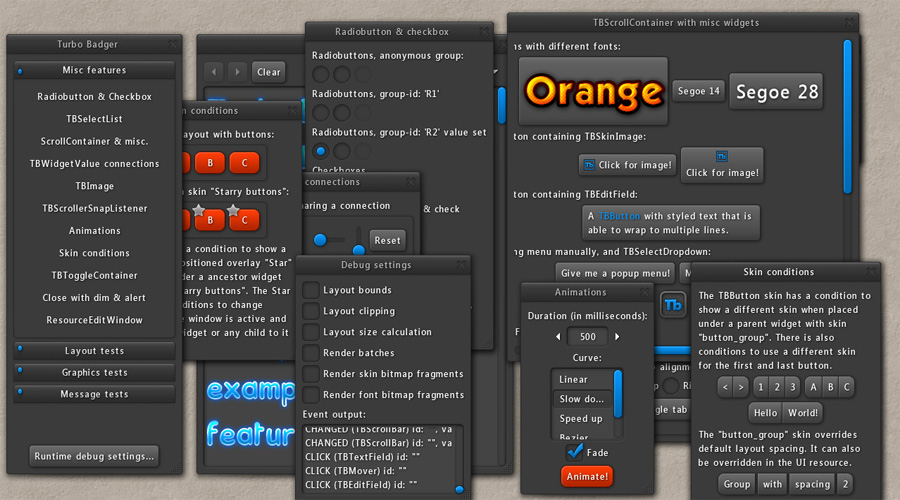
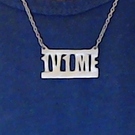

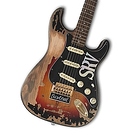
 You did an awesome work ! I can’t see the reason why devs won’t implement this as an official subsystem ? Looks professional , there are way more widgets , and could boost the editor’s appereance and it would attract more users.
You did an awesome work ! I can’t see the reason why devs won’t implement this as an official subsystem ? Looks professional , there are way more widgets , and could boost the editor’s appereance and it would attract more users.
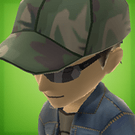
 It is another good UI framework option and setting up a repo where you can improve and fully integrate it is a big plus! I’m also thinking of using this as an alternative to Qt, due to its hefty payload.
It is another good UI framework option and setting up a repo where you can improve and fully integrate it is a big plus! I’m also thinking of using this as an alternative to Qt, due to its hefty payload.
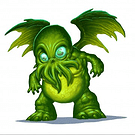

 ) What consumed a vast portion of my time and mental energy was how to integrate TB as part of other Third Party library and how its interface would be wrapped and exposed for use in Urho3D. Is it going to replace the existing UI system or will it be part of custom UI structure that would be implemented in Urho3D?
) What consumed a vast portion of my time and mental energy was how to integrate TB as part of other Third Party library and how its interface would be wrapped and exposed for use in Urho3D. Is it going to replace the existing UI system or will it be part of custom UI structure that would be implemented in Urho3D?




